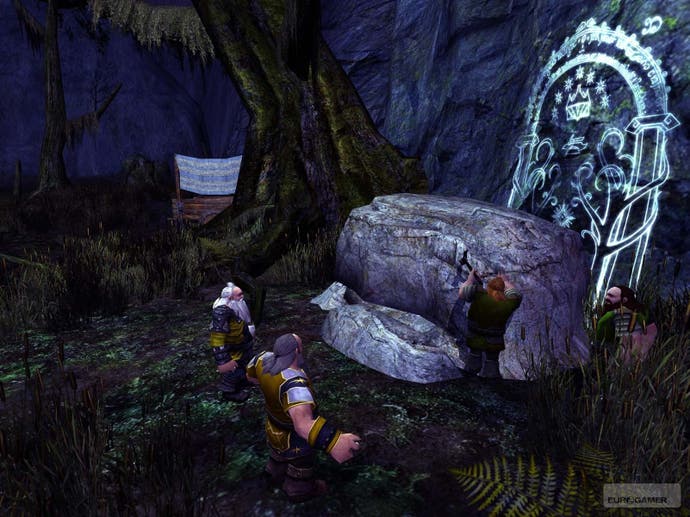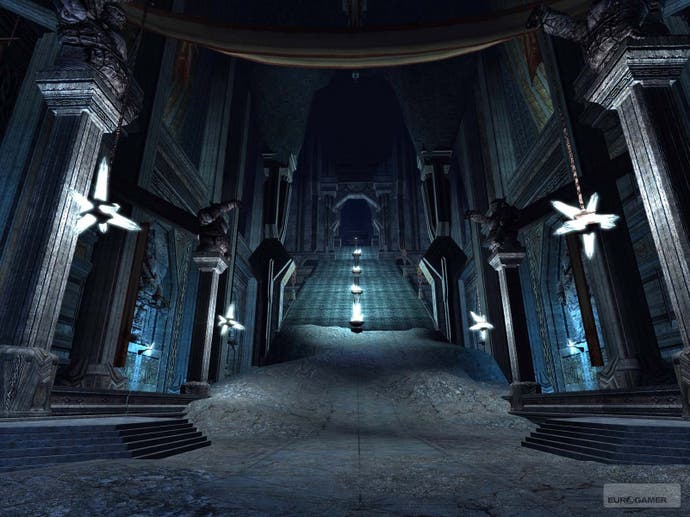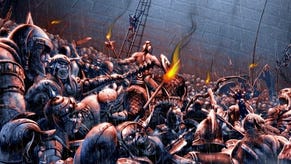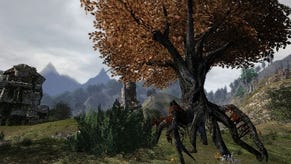The Lord of the Rings Online: Mines of Moria
Dungeon calling.
Physically contained it may be, but the depths of Moria provide the Turbine team with far greater artistic licence than pastoral Eriador did. Beneath the halls are the great forges of Khazad-Dum, worked by hulking Trolls and smothered in heat haze; the misty waterworks, with huge and desolate Gothic architecture that recalls Ico; and the "nameless deep". Here, given free reign by Tolkien's words, Turbine has let rip in a horrific fungal labyrinth infested with giant insects, demons and headless horrors.
Moria is under-populated at the moment, and while our tour takes in some truly amazing sights, we can't yet get a feeling for its overall size and how it fits together. But there's no doubt that Tolkien has inspired Turbine to some of the most focused, thought-out and atmospheric world-building in MMOs to date. Future free updates will expand the Mines as well as move players further east towards Fangorn Forest, Rohan and Eisengard; we imagine you'll be as eager to return to its mysteries as you are happy to emerge into Loth Lorien for the first time.
Class action
Unconventionally designed, Mines of Moria's two new classes don't plug gaps in the LOTRO line-up so much as create new ones for themselves. The Rune-Keeper - an out-and-out magic user who can change from a mage-style ranged damage-dealer to a healer from one fight to the next - is the more daring of the two, not least because it stretches Turbine's interpretation of Tolkien's world to the breaking point. The Warden is a lightly armoured, shield-and-spear-carrying tank with some stealth abilities, and an intriguing spin on the skill combo system that's all the rage in MMOs at the moment. Both are intended to have a more direct, pacy feel in combat.

The Rune-Keeper, inspired by Galadriel, flies in the face of received MMO wisdom by allowing players to change their group role dynamically according to how they play, rather than requiring them to switch between talent-tree builds or armour sets. An on-screen gauge tracks how attuned you are to either healing or destructive magic; the more healing spells you use, the more you'll unlock and the greater power you'll have a healer, while you lose offensive spells and power. The same goes the other way around. You can use carefully balanced spell rotations and Trait selection to balance yourself somewhere in between the two, but even at extremes the Rune-Keeper isn't a substitute for a Minstrel at healing or a Hunter in ranged damage - instead, most of its spell heal or damage over time, creating a more proactive than reactive play style.
Despite its reverentially careful treatment of the source material elsewhere, and the fact that actual wizards are extremely rare in Middle-Earth, Turbine has chosen to put the needs of the RPG fan-base first for once - "you've just got to have magic users", executive producer Jeffrey Steefel says. The one sop to the lore nerds is to characterise the Rune-Keeper as a linguist using the power of words - perhaps that's enough in keeping with Tolkien's own enthusiasms to slow the great man's grave-spinning somewhat.
The Warden, based on Haldir, wears medium armour, carries a shield, and uses javelins as both melee and medium-range throwing weapons; it's a decent pulling and tanking class that avoids damage, rather than mitigating it with heavy armour. Its gimmick is the Gambit system that allows players to build up to a selection of powerful skills through preset combos of offensive and defensive moves, and taunts.

There are some 40 different combinations you can use to assemble skills, and plenty of flexibility to change your plan halfway through; you begin with two-skill Gambits, but progress to five skill slots as you level up. Unlike most similar systems, the combo can be interrupted while you perform other attacks, transferred to another enemy, or the final gambit saved for later use. The Warden is a supremely flexible short-term tactician, and designed to be a superior solo class, as tanks go.
Playing both classes through the early levels, we thoroughly enjoyed the Warden; although basic at this point, the potential for a melee class that's both technically deep and viscerally satisfying to play is clear. The Rune-Keeper is harder to judge. Played solo, healing - and thus half the class design - are seldom used. The seesaw from damage to healing attunement and back again feels laboured and limiting, but this might just be the lack of options at such a low level. If it can balance the class correctly and make it satisfying to play, Turbine will have pulled off an audacious conjuring trick of an RPG hybrid - but the jury's out.








